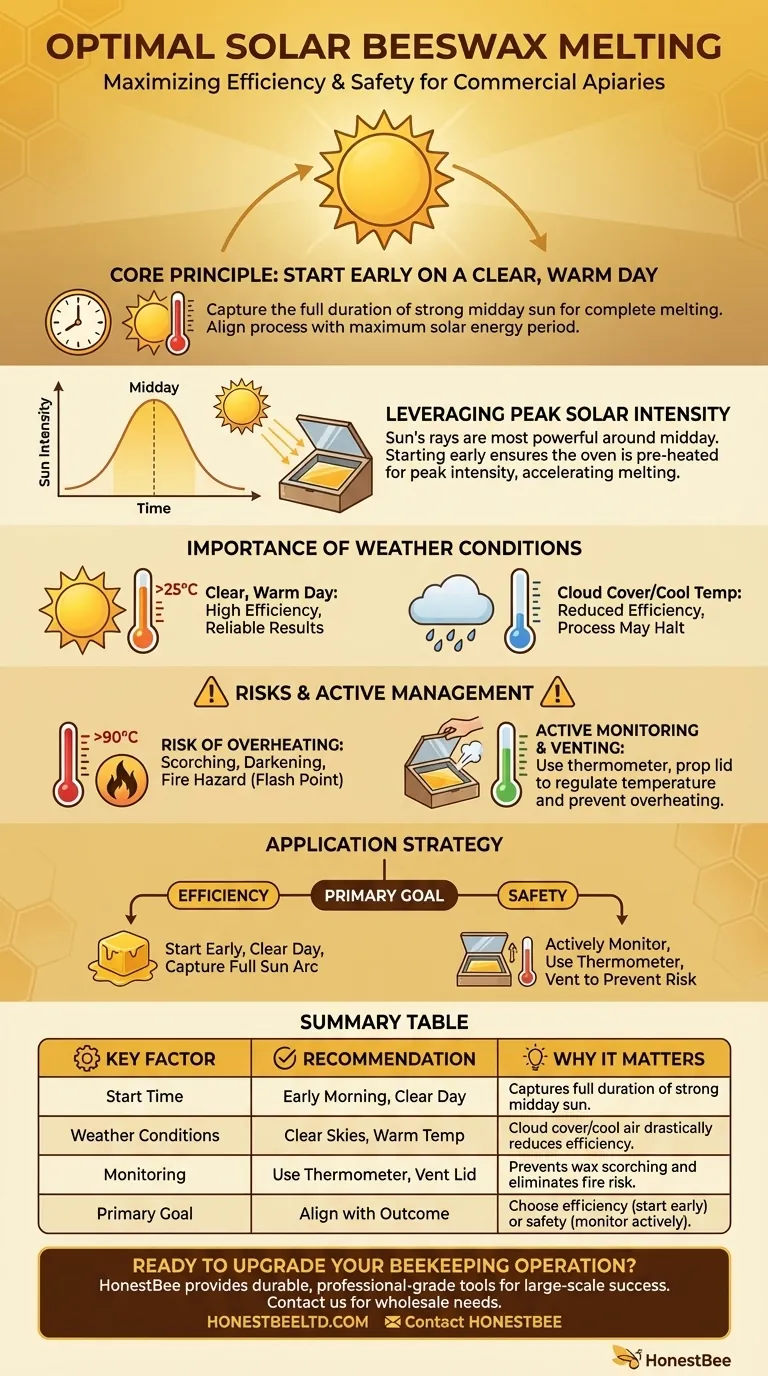To successfully melt beeswax, you should start the process early in the day on a clear, warm day. This strategy ensures your solar oven is positioned to capture the most direct and powerful midday sun, giving the wax sufficient time and thermal energy to melt completely by the end of the day.
The specific start time is less important than the underlying principle: you must align the melting process with the period of maximum solar energy. Success depends on capturing the full duration of strong, direct sunlight, not just a specific hour on the clock.

The Principles of Solar Wax Melting
To use a solar oven effectively, you need to think like the sun. The goal is to collect and retain as much thermal energy as possible over several hours.
Leveraging Peak Solar Intensity
The sun's rays are most powerful around midday. Starting the process earlier in the morning allows your oven to begin absorbing heat and prepares it to take full advantage of this peak period.
By starting early, you ensure the oven is already warm when the strongest sunlight hits, accelerating the melting process significantly.
The Importance of a Clear, Warm Day
Solar ovens are entirely dependent on direct sunlight. Cloud cover will dramatically reduce the oven's efficiency and can halt the melting process altogether.
Similarly, cooler ambient temperatures mean the oven has to work harder to build and retain heat. Always choose a warm, sunny day for the most reliable results.
Duration and Expectations
Melting a significant amount of beeswax is not an instant process. It requires sustained heat over several hours.
Placing your oven in the sun in the morning provides the necessary window of time for the wax to fully liquefy. If you start too late in the afternoon, you will likely run out of daylight before the job is done.
Understanding the Risks and Limitations
While simple, the solar method is not without its challenges. Understanding the potential pitfalls is key to ensuring both safety and a high-quality result.
The Risk of Overheating
A well-designed solar oven can become surprisingly hot. If left unchecked, temperatures can rise high enough to scorch the beeswax, darkening its color and giving it a burnt odor.
More critically, excessive heat can bring the wax to its flash point, creating a serious fire hazard. Never leave a solar oven unattended for long periods.
Managing Temperature Actively
The key to preventing overheating is active monitoring. Use a thermometer to periodically check the internal temperature of the oven.
If you find the temperature is climbing too high, you can easily regulate it by propping the lid open slightly. This allows excess heat to vent while still maintaining a temperature high enough to melt the wax.
The Limitation of Solar Power
The most obvious trade-off is weather dependency. This method is completely ineffective on overcast, rainy, or cool days. It requires planning around the weather forecast.
How to Apply This to Your Project
Your approach should be guided by your primary goal, whether that's simple efficiency or ensuring maximum safety.
- If your primary focus is efficiency: Start early on a day forecasted to be clear and warm to capture the complete arc of the midday sun.
- If your primary focus is safety: Actively monitor the oven's internal temperature with a thermometer and be prepared to vent the lid to prevent scorching or fire risk.
Ultimately, harnessing the sun to melt beeswax is an effective method that rewards careful planning and observation.
Summary Table:
| Key Factor | Recommendation | Why It Matters |
|---|---|---|
| Start Time | Early morning on a clear, warm day | Captures the full duration of strong midday sun for complete melting. |
| Weather | Clear skies, warm ambient temperature | Cloud cover or cool air drastically reduces the oven's efficiency. |
| Monitoring | Use a thermometer; vent lid if needed | Prevents wax from scorching and eliminates fire risk from overheating. |
| Primary Goal | Start early for efficiency; monitor for safety | Aligns your actions with your desired outcome, whether speed or security. |
Ready to upgrade your beekeeping operation with professional-grade equipment?
As a trusted wholesale supplier to commercial apiaries and distributors, HONESTBEE provides the durable, efficient tools you need for large-scale success—from solar wax melters to essential hive management supplies. Our bulk-focused operations ensure you get the reliable equipment your business depends on.
Contact HONESTBEE today to discuss your wholesale needs and discover how our solutions can enhance your productivity and profitability.
Visual Guide

Related Products
- Professional Thermostatic Conical Honey Melter
- Honey Concentrating Vacuum Heating Thickening Machine Dehumidifier for Honey
- HONESTBEE Advanced Ergonomic Stainless Steel Hive Tool for Beekeeping
- Professional Frame Preparation: The HONESTBEE Electric Wire Embedder
- Professional Dual-End Stainless Steel Hive Tool for Beekeeping
People Also Ask
- What is melter honey used for? A Low-Cost Ingredient for Bakers and Brewers
- At what temperature does honey flow? Preserve Quality with the Perfect 95°F Sweet Spot
- Why is it important to heat honey slowly and evenly? Preserve Flavor, Nutrients & Value
- What are the negative effects of overheating honey? Preserve Your Honey's Natural Quality
- What is the effect of heating on honey? Preserve Quality with Controlled Warming

















